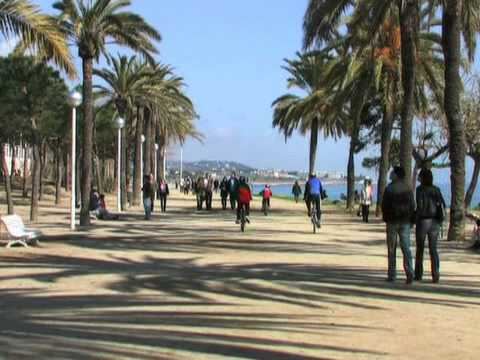Demonym(s) Mataroní Area 22.5 km² | Elevation 28 m (92 ft) Website mataro.cat Population 124,280 (2014) Local time Wednesday 3:30 AM | |
 | ||
Weather 12°C, Wind NW at 6 km/h, 68% Humidity | ||
Mataró ([mətəˈɾo]) is the capital and largest city of the comarca of the Maresme, in the province of Barcelona, Catalonia Autonomous Community, Spain. It is located on the Costa del Maresme, to the south of Costa Brava, between Cabrera de Mar and Sant Andreu de Llavaneres, 30 kilometres (19 miles) north-east of Barcelona. As of 2010, it had a population of c. 122,932 inhabitants.
Contents
- Map of MatarC3B3 Barcelona Spain
- History
- Main sights
- Agriculture
- Climate
- Festivals celebrations and events
- Twin towns
- References
Map of Matar%C3%B3, Barcelona, Spain
History
Mataró dates back to Roman times when it was a village known as "Iluro" or "Illuro". The ruins of a first-century BC Roman bath house (known locally as the Torre Llauder) were recently discovered and can be visited. The coastal N-II highway follows the same path as the original Roman road.
Mataró was declared a city by royal decree, even though at the time (nineteenth century) the population fell short of the requirement for city status.
The first railway in peninsular Spain was the Mataró – Barcelona line which opened on 28 October 1848 by the Catalan businessman and Mataró native Miquel Biada. This line now forms part of the RENFE/Rodalies de Catalunya R1 suburban service between L'Hospitalet de Llobregat and Maçanet-Massanes. Mataró is also connected with Barcelona and Girona by the C-32 autopista (freeway) and with Granollers by the C-60 autopista.
During the 1992 Summer Olympics in Barcelona, Mataró was the starting point for the marathon events.
Main sights
Mataró is the birthplace of noucentista architect Josep Puig i Cadafalch, who designed the ajuntament (town hall) and several other notable buildings in the town:
Nearby the town are the archaeological remains of the Roman villa of Can Llauder.
Agriculture
The traditional vineyards were devastated by Phylloxera in the nineteenth century and only partially replanted, due to the growth of the tourist industry and the development of irrigation in the area. Potatoes were one of the first replacement crops to be introduced, especially the Royal Kidney variety, and Mataró obtained a Denominació d'Origen in 1932. Trocadero lettuce and peas are also grown, mostly for export. The production of cut flowers is less important than in other towns of the Maresme. Irrigated land made up 9.13 square kilometres (3.53 sq mi) of the 10.57 square kilometres (4.08 sq mi) of agricultural land in the municipality in 1986 (47% of the municipal territory).
Climate
Mataró has a borderline humid subtropical climate (Cfa in Köppen climate classification) bordering with a Hot-summer mediterranean climate, (Köppen Csa).
Festivals, celebrations and events
Several major events are celebrated annually in Mataró. Some of them are also celebrated in the rest of Catalonia and others, which have a religious origin, are part of the folklore and traditions of Spain and some other countries. Among all of them the most popular ones are:
